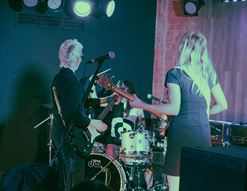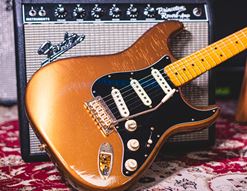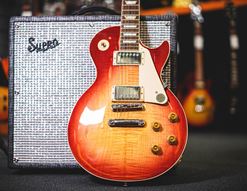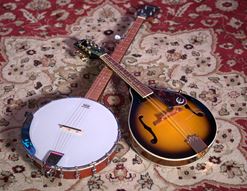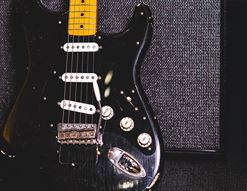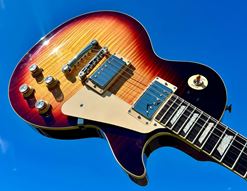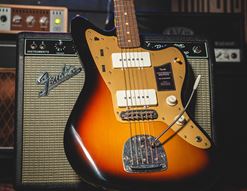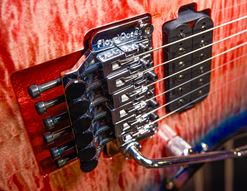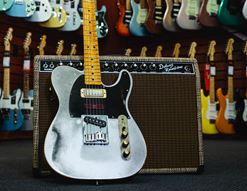Electronic music: the music of the future. The soundtrack to a sci-fi tomorrow; the sound of rebellion in the late 80s. From a number of cultural hotbeds (Detroit, Dusseldrof, New York, Berlin, Bristol etc), electronic music has appeared in numerous guises and styles, with a general purpose of benign people together and moving towards a more utopian future.
Electronic music has actually been around in some form or another for about a century, believe it or not. The relentless urge to innovate can be seen quite clearly in elemental keyboard instruments that used early versions of samples, and there’s a through-line that you can trace right up to today.
It’s quite a history, but what of it? What of the music itself? The artists? Today, with a tacit understanding that the subject is too impossibly huge to accurately curate, I’ve put together a list of what I feel are some of the most significant albums in the history of electronic music. I’ve not made it an elitist list of obscurity, and neither have I felt indeed to pander to any particular scene. I’ve tried to represent it all, but you can be the judge of that.
What’s obvious to me is that electronic music often comes to us as songs and DJ sets, rather than full albums, due to the nature and purpose of much of it. Still, I want to highlight the albums that I believe are particularly notable.
Whatever electronic music means to you, I hope you can find some amazing gems of texture, rhythm, melody and noise right here.
The Albums at a Glance
Switched-On Bach - Wendy Carlos
20 Jazz Funk Greats - Throbbing Gristle
Apollo: Atmosphere & Soundtracks - Brian Eno with Daniel Lanois and Roger Eno
Lifeforms - Future Sound of London
Interstellar Fugitives - Underground Resistance
Selected Ambient Works Vol 2 - Aphex Twin
Switched-On Bach - Wendy Carlos
Wendy Carlos is a huge figure in the world of synthesizers. We know her music - whether from her own albums or from soundtracks to Tron, A Clockwork Orange & The Shining - but her influence goes a lot further. Carlos actually consulted with Robert Moog himself when he was developing the original Moog synths, to the point where she was credited with several of the features! It was her musical ambitions that fuelled ideas like touch sensitivity, portamento controls and more.
In between consulting on the world’s most famous synth and scoring some huge movies, Carlos released an album called Switched-On Bach, which changed everything. As you’d guess, it was classical Bach compositions, all played on synthesizers. Nothing like this had ever existed before. This album, more than any other, legitimised the synth as a viable instrument, and one of versatility and scope.
Phaedra - Tangerine Dream
Tangerine Dream are a hugely influential German synth band, whose 70s heyday was led by Edgar Froese. They have many top-tier albums, but my choice for significance is 1973’s Phaedra. The record has only 4 songs, but the title track itself is almost 18 minutes long, which may help explain the expansive ambition contained within.
Tangerine Dream literally pushed their synthesizers to the limit during Phaedra: towards the end of the piece, their analog synths actually began to overheat and go out of tune, and that’s why the music changes in the song’s later stages! There are Moogs, mellotrons and phasers aplenty on this labour of love. Here’s what Froese said about a typical day:
“Just tuning the instrument took several hours each day, because at the time there were no presets or memory banks. We worked each day from 11 o'clock in the morning to 2 o'clock at night. By the 11th day we barely had 6 minutes of music on tape. Technically everything that could go wrong did go wrong. The tape machine broke down, there were repeated mixing console failures and the speakers were damaged because of the unusually low frequencies of the bass notes. After 12 days of this we were completely knackered.”
Guys, it was worth it!
The Man Machine - Kraftwerk
Kraftwerk are obviously one of the most innovative and influential electronic artists in the world. Their entire body of work bristles with invention, atmosphere and a commitment to synthesis and futurism. Hailing from a postwar - and widely rebuilt - Dusseldorf, Kraftwerk’s music presents a distinct rejection of the past and an optimistic gaze towards the future.
The hard part today was which albums of theirs to include! Would it be the sound-defining Autobahn? The intimate depth of Computer World? In the end, I went with 1978’s The Man Machine, purely for the songs. From opener The Robots, to hit single The Model to the utterly sublime Neon Lights, this is an album of timeless beauty.
Low - David Bowie
David Bowie, an electronic music pioneer? I’d say so, for widespread influence as much as the value of the music itself. Low was the first of the Berlin trilogy, a suite of records (mostly) recorded at Hansa Studios in Berlin. Low was a response to Bowie’s chaotic life and drug misuse whilst living in Los Angeles in the mid-70s. He desired a city that was as un-LA as possible and, at the time, Berlin fit the bill.
It’s difficult not to feel the iciness of the segregation and the Berlin Wall in this record, which is half instrumental and half vocal tracks. If a sense of alienation is prevalent in lot’s of Bowie’s work, that’s its inescapable here, whether his vocals are present or not. Quasi-symphonic epics like Warsawa rub shoulders with edgy, slightly paranoid tracks like Art Decade, every track glowing with Bowie and Brian Eno’s synthesizers. Low brought electronic music and ambient music to an audience who were more familiar with Ziggy Stardust. Game-changing? Most definitely. Brave? Hugely.
20 Jazz Funk Greats - Throbbing Gristle
Throbbing Gristle and the associated groups and artists in their orbit (Coil, Psychic TV, Chris & Cosey, Current 93 etc) could fill many a blog with interesting, relevant and sometimes worrying content, but this brief entry will have to do for today. Throbbing Gristle were as much an experimental art project/collective as they were a band, and are generally credited with inventing industrial music.
20 Jazz Funk Greats is possibly the most sarcastic album title of the 70s. It’s Throbbing Gristle’s third album, and is filled with sounds from Roland and BOSS gear. Electronic rhythms pulse next to blasts of noise which, although not as intense as other TG moments, still adds up to an intense and hugely influential listen.
Fact magazine, who specialise in electronic music, says a particularly excellent thing about 20 Jazz Funk Greats. Check this out: "This album is a rupture. It's an open crack into the unpronounceable dimensions into which tumble important streams of 20th-century pop, art and underground culture, to seethe around each other, mingling, festering, sprouting new and unpredictable forms which in turn would ooze out to infest vast sections of what comes after."
Enter - Cybotron
Detroit is the home of techno and house music. Period. And this record by Cybrotron - otherwise known as Juan Atkins - is where the story of Detroit techno begins. It’s a gloriously spacey sound that, to my ears, shares a lot of the ‘future-optimism’ of Kraftwerk, without sounding overly like them.
Indeed, some songs have traditional singing and electric guitar solos, neither of which are typically regarded as being particularly ‘techno’. That said, this was the necessary step towards the futurism and clean/cold aesthetic that the genre would soon typify.
It’s dated, but in a very endearing way. The recording quality is excellent, the ideas are big and the whole record just transports you to a wonderful 80s parallel universe.
“Technofy your mind, we are just dreams in space, stranded in this funky place”. Well said!
Apollo: Atmosphere & Soundtracks - Brian Eno with Daniel Lanois and Roger Eno
Brian Eno is a significant element on a lot of great music, not least his own. Even if he didn’t invent ambient music, he certainly brought it into mainstream acceptance, and this particular album seems to have a relevance that is greater than other Eno works.
Apollo was actually Eno’s response to the moon landings themselves, in that he was disappointed that the TV footage didn’t have appropriate music. A decade later, he righted that wrong with the help of his brother and musician/producer Daniel Lanois.
The record is impressionistic and characteristically textured, but there’s a sense of awe and wonder to much of the album that isn’t found as often on Eno’s other records. The track An Ending (Ascent) has been widely used in movies too, from 28 Days Later to Traffic.
Violator - Depeche Mode
Initially written off as pretty-boy synthpop posers, Depeche Mode showed the world their dark 'n' sexy side with 1990’s Violator. It’s a gloomy record, but one that glows through the gloom, and always has one kohl’d eye focussed on the dancefloor.
Depeche Mode are one of the very few bands who’ve been able to combine cutting edge electronic music with genuinely decent songwriting. Violator came around during a purple patch for them that also bore Music For the Masses and Songs of Faith and Devotion. By this point, they were as big as U2.
All these years later, Violator has lost none of its appeal, and in fact has hardly aged a day, soundwise. Now that is a good trick to be able to pull off!
Lifeforms - Future Sound of London
Future Sound of London deserve to be thought of in the same way that Aphex Twin is: as pioneering innovators who carved a very unique path through music. Arguably, FSOL achieved it more successfully at the time, not only bringing an exotic blend of techno, ambient and psychedelia to the masses, but changing the very way touring was approached. Their ISDN touring idea was a game-changing that still feels futuristic (google it!). Also, who else has ever managed to get a 40 minute long single into the UK Top 30 chart?!
Band member Gary Cobain once spoke of his frustrations of the 1990s, in that the available technology couldn’t facilitate his ambitions!
It didn’t stop him and musical partner Brian Dougans from creating some of the most colourful, expansive and forward-thinking music ever, though. Bursting apart all genres, FSOL seems to have chosen the entire planet as colours for their musical paintbrushes. Lifeforms is my choice for you today, because it’s such an uncompromising realisation of vision and ambition. It’s ambient, yes, but also a completely immersive listening experience, and one like no other.
Timeless - Goldie
Drum n bass was a cultural watershed in the mid 90s that is now seeing something of a reemergence. Praise be, then, to the movement’s figurehead, Clifford Joseph “Goldie” Price, whose 1995 album Timeless has ultimately proven to be just that.
For a debut album, the confidence is astonishing. One track is 12 mins long and Timeless - the famous title track - clocks in at just over 21 minutes! Timeless set the bar in terms of defying expectations, combining elements and creating music that had genuinely never been heard before.
Fat of the Land - The Prodigy
Is this The Prodigy’s best album? It’s hard to say, but it’s easily the one that caught the biggest wave back in 1997. Fat of the Land dabbled in multiple electronic genres, putting mastermind Liam Howlett’s inimitable stamp on each. They also deliberately courted controversy with the single ‘Smack My Bitch Up’, particularly with the promo video.
The 90s were a different time!
This album was HUGE - more than expected by quite a margin - and was actually spoken about at the time as being more significant than both U2’s Pop album and Radiohead’s OK Computer by the trades.
Prior to Fat of the Land, The Prodigy were already a subversive proposition, an anarchic melding of the works of rock and rave who broke from the underground warehouse rave scene into the mainstream. They rocked harder than rock bands, without requiring guitars or drum kits (though those were featured live for the spectacle) and in twin frontmen Keith Flint and Maxim Reality, they had the edgiest, most iconic rock stars of the decade.
Interstellar Fugitives - Underground Resistance
Underground Resistance are a mainstay of the Detroit scene, and feature that city’s characteristic sci-fi aesthetic amongst the pounding Afrofuturism of their music.
Underground Resistance has included Detroit techno legends Jeff Mills and Robert Hood amongst their ranks, who are both responsible for some of the most incredible minimal techno ever. It’s maybe fair to say that their individual songs are more influential (within playlists) than particular albums, but this UR release deserves inclusion here for sure. It’s also relatively minimal techno, and particularly resonates due to its darker, more dystopian sound. Could it be the influence of the city itself? I’d say definitely yes.
There’s something very ‘city’ and ‘night’ about this album, at least to my ears. UR have been making music since the 80s, but this 1998 record is the one that I would argue has made the biggest mark.
Geogaddi - Boards of Canada
Mysterious Scottish electronic duo Boards of Canada have certainly built and sustained a personal mythology around their work. Tales of remote countryside studios, banks of vintage gear and periods in isolation in the wilderness is what we hear about these two, and whether that’s true or not (does Hexagon Sun really exist? I have my doubts...), it infects our perception of their work.
Geogaddi, the duo’s second record, is a significant piece of work. A sombre and introspective departure from their previous work, Geogaddi is a real example of just how haunted electronic music can be. Within the tracks are subliminal messages, occult references and even audio recordings of Branch Davidian leader David Koresh’s name. It’s a deep work, and unusual (many of the 23 tracks are little over a minute long, with one being only 38 seconds), but well worth investing time in.
Selected Ambient Works Vol 2 - Aphex Twin
Talking about mythological electronic artists, they don’t come more mysterious or unpredictable than Richard D James, also known as Aphex Twin. The Irish-born, Cornwall-raised artist has become an icon almost despite himself, and whilst his ‘Come to Daddy’-era noise and visuals is certainly what made him visible to music fans, his enduring appeal lies as much (moreso?) in his ambient records. Both Selected Ambient Works albums are masterpieces, created with a range of technologies partly built by James himself. Vol 2 is the one that gets the fans hyperventilating though. There are no song titles at all, so people instead refer to the photographs that appear on the back cover in place of titles. That’s just the beginning of mystery with this music, but I won’t spoil the rest!
Singularity - Jon Hopkins
Today’s final choice is a relatively recent one. Singularity is a wonderful thing to get into your ears. Is this ambient music? I wouldn’t say so. Soundtrack music? Soundtrack for what? I’d simply call Singularity an ‘experience’, that illuminates and enthralls.
It’s not so much that Hopkins is reinventing the wheel as much as he is delivering a series of immersive, impeccably produced ‘sound-stories’, for want of a better term. I am starting to sound a bit pretentious now, so I’ll simply say that this is an essential record for fans of electronic music.
The Tip of a Beautiful Iceberg
That tiny list of music barely begins to scratch the surface of the wonderful world of electronic music. There is so much out there to love, and it comes in so many colours and flavours, from music that’s close to classical music, to stuff that sounds best blasting from a sound system at night in a farmer’s field somewhere. Electronic music can be political, escapist, impressionistic or as direct as punk or metal.
It’s all out there, and I hope you decide to follow a few of the paths that this blog has laid down for you.
If you liked this, please read my Electronic Music Subgenres blog!

